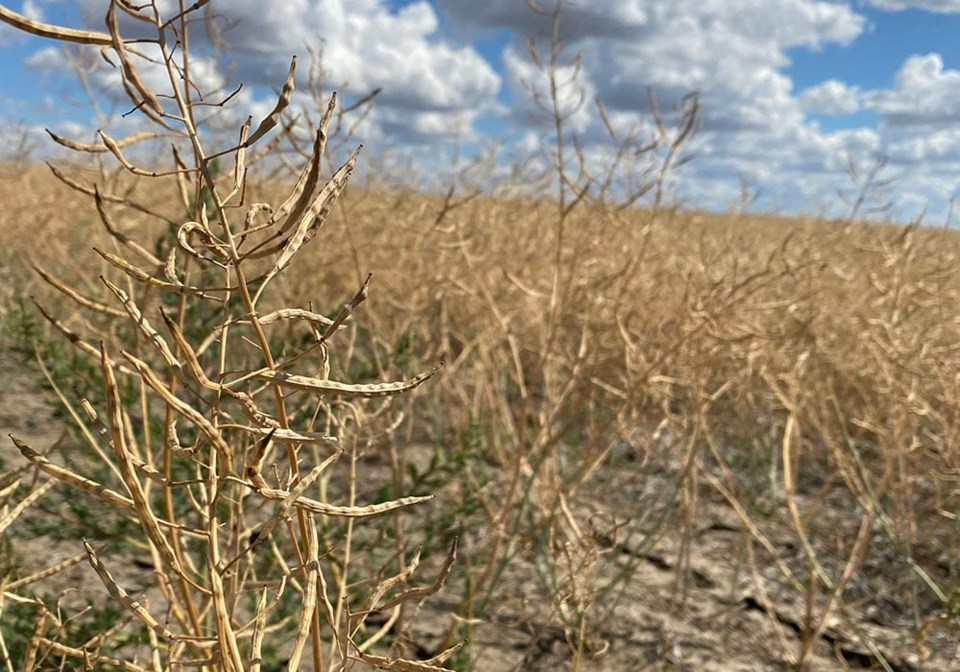WESTERN PRODUCER — No hands went up when MarketsFarm analyst Bruce Burnett asked farmers if their yields will be as good as last year.
One grower said his would be one-quarter of what they were a year ago.
“I drove through some of those areas,” Burnett said during his market outlook presentation at the Ag in Motion outdoor farm show held July 18-20 in Langham, Sask.
“It’s crop insurance territory.”
MarketsFarm has released its initial yield forecast for Western Canada and it is downright ugly.
The spring wheat yield is pegged at 44 bushels per acre, a 17 percent decline from last year.
In a lot of years, the drought areas are offset by high-yielding regions of the Prairies.
“That is not happening this year because the really good areas are going to be about average to maybe a little bit below average,” he said.
Canola is forecast at 33 bu. per acre, a 13 percent drop.
Establishment was a big problem for the oilseed, even in areas with good moisture.
“There are a lot of spotty patches in canola,” he said.
The canola crop is looking “substantially worse” than the wheat crop in the good areas of the Prairies.
Barley is estimated at 56 bu., a 20 percent decline, while durum yields are expected to come in at 26 bu. per acre, a 24 percent freefall.
Burnett said there is a potential downside to his estimates, given that the forecast is for hot and dry conditions for the next couple weeks.
“We probably are going to lose some bushels from some of these areas,” he said.
Production of the major crops like spring wheat, canola and is forecast to be down between nine and 11 percent compared to last year.
All-wheat production is forecast at 30.4 million tonnes, well below the U.S. Department of Agriculture’s estimate of 35 million tonnes.
Smaller crops like durum, lentils, peas and oats will be hit harder, with production falling between 20 and 49 percent compared to last year.
The global durum market needed 4.5 to five million tonnes of production out of Canada, but Burnett is forecasting 4.1 million tonnes and fears it could drop as low as 3.9 million.
“That’s going to have a substantial impact on the durum market,” he said.
There is huge demand for durum out of North Africa and Italy, yet today’s offers are below spring wheat values.
“That makes absolutely no sense in this type of scenario,” he said.
When asked if canola prices will return to last year’s lofty levels of $20 per bushel, Burnett said that will largely depend on the U.S. soybean crop. The forecast for the corn belt is for hot and dry conditions over the next few weeks.
“If their crop gets very much smaller, then I certainly could see vegetable oils rallying to the point where you would get canola in that $20 range.”
The other way it could happen is less desirable, which is if his canola production forecast of 16.5 million tonnes drops another one million tonnes between now and harvest.
Burnett said Western Canada’s are because of poor subsoil conditions in the western half of the Prairie region heading into the growing season, followed by lacklustre rains so far this year.
Northern Alberta is the only region of the Prairies that has received normal rainfall since April 1.
A lot of the crops with the biggest production declines, such as durum and lentils, are produced in southwestern Saskatchewan and southern Alberta, where the drought is most pronounced.
Burnett said the agriculture industry won’t have to wait too long to see if his yield forecasts are correct because the crop is about seven to 10 days ahead of normal development.
“We had an opportunity to produce a decent crop this year, but we just didn’t get the weather for it,” he said.
“Welcome to farming on the Prairies.”




